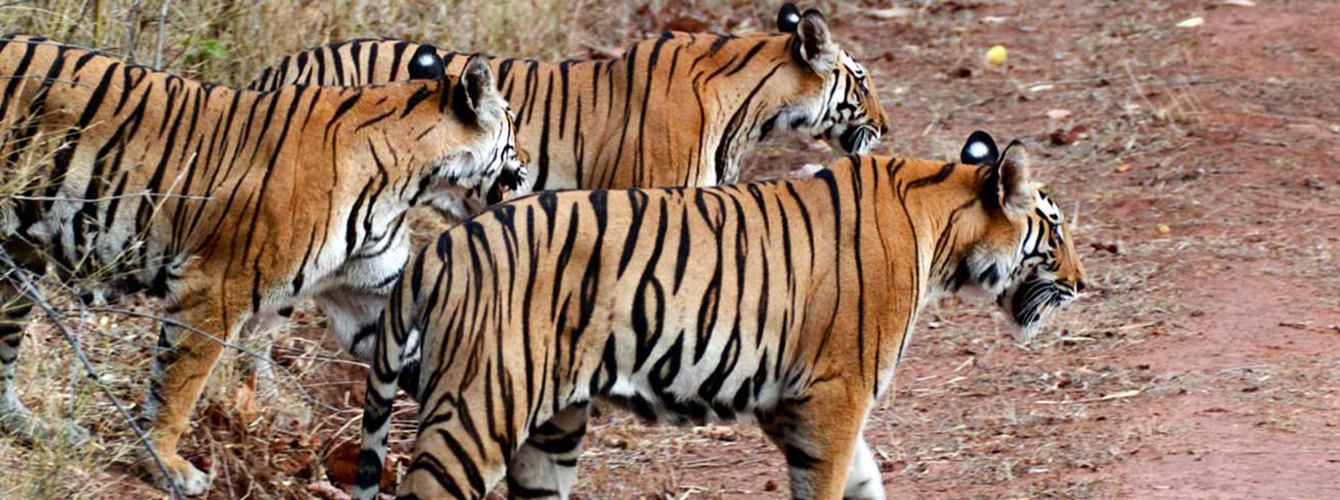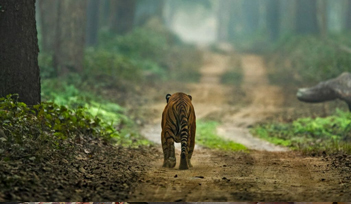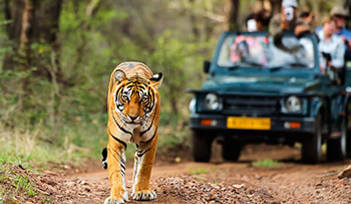Home > KATARNIAGHAT Wildlife Sanctuary
Welcome To KATARNIAGHAT Wildlife Sanctuary
Along the Indo ? Nepal border , in the district of Behraich in Utter Pradesh , India, lies a 550 sq. km. of dense Terai jungle comprising of Sal and Teak forest, Lush green Grasslands, wetlands and swamps which are full of life. A river which forms an intrinsic part of this forest flower silently supporting the last of the Gharial populations left in the wild.
Once part of the West Behraich Forest Division , the wild and green wonder was declared a Wildlife Sanctuary in May 1975 and today forms a part of the Dudhwa Tiger Reserve along With Dudhwa National Park and Kishanpur Wildlife Sanctuary.
The sanctuary also form an important corridor of connectivity between the Dudhwa Tiger Reserve in India and the Bardia National Park in Nepal. The Sanctuary comprises of the forest in the ranges of Motipur, Kakraha, Murthia, Nishangarah, Dharmapur and Karerniaghat. This distance from Motipur to KATARNIAGHAT is of around forty kilometers and a slow drive along the road provides ample sighting of the wild fauna, with the journey ending at the river Girwa.
THE FOREST
The woodland in the sanctuary are dominated by Sal (Shorea robusta) and Teak (Tectona grandis) trees which generally form the top canopy with Asna (Terminalia alata), Asidh (Lagerstroemia parviflora), Bahera (Terminalia belerica), Haldu (Adina cordifolia) and Kusuma (Schleichera oleosa). The middle level of the forest consists of Rohini (Mallouts pkillippensis), Gular (Ficus glamerrata), Khurkhura (Ficus conia), Banyan (Ficus bengalensis), peepal (Ficus religiosa). The tree found near the river and water- bodies are Jamun (Syzygium cumini), Partju (Patranjiva roxburghii), Sheora (Streblus asper), Shiisham (Dalbergia sissoo), Semal (Bombax ceiba), Khair (Acacia catechu), Gutel (Trewia nudiflora) etc.
The grassland which are generally formed on old river beds and silted lakes are called ?Phantas? in the local languages. These generally intermingle with the forest. The main grasses found in these Phantas are Munj (Saccharum munja), Kans (Saccharum spontaneum), Narkul (Phragmites karka) and Nari (Arundo donax).
The grassland which are generally formed on old river beds and silted lakes are called ?Phantas? in the local languages. These generally intermingle with the forest. The main grasses found in these Phantas are Munj (Saccharum munja), Kans (Saccharum spontaneum), Narkul (Phragmites karka) and Nari (Arundo donax).
CREATURE OF THE FOREST
The unusually calm forest, at time echoes with the alarm call of a Cheetal (Axis axis) or Langur (Semnopithecus), this alerts all the inhabitants of the forest of the presence of the king ? The Tiger , an ellusive animal, the presence of which can be felt by the pug marks, scratch marks and scat . It rarely shows itself and usually avoids humans. But this majestic animal when sighed in its natural surrounding is a moment to cherish forever.
Many other species of animals like the Leopards, Cheetal or Spotted Deer, Hog deer, Barking Deer, Swamp Deer and the Sambar live in the Sanctuary and play equally important part in its ecology. Elephant and Rhino which once migrated from Nepal, have now made KATARNIAGHAT their permanent residence. Wild boar can be easily seen here. At dusk, the creatures of the night- Porcupines, Civet, Jackals and bats become active and one should keep a look out for them. The sanctuary also has an Albino spotted Deer which can be seen in the herd of the other Cheetals.
THE TALS AND SWAMPS
The Tals or lakes and the swamps play an important part in the ecology of the sanctuary and are home to Muggar Crocodiles, water birds, Otters and a host of migratory birds during the winter months
GHARIAL
The Gharial (Gavialis gangeticus) is easily distinguished from other crocodiles , for it has a long and narrow snout with a bulbous like swelling around the nostrils used for communication .Males generally have these bulging swelling, which look like a pot ( or Ghara in hindi ) hence the name. The Gharial, primarily a fish eater occasionally also feeds on turtles and other small animals . Today Gharial is a critically endangered species and the Girwa River, with its sand bars, provides the perfect home for the Gharial to bask and breed . From the banks of Girwa one can easily see them basking in the sun.
BIRDS
A great variety of habitats at KATARNIAGHAT is reflected in its rich bird life. The Tals, Swamps and Girwa river along with the reservoir of the Ghaghra Irrigation Barrage are host a wide variety of megratony birds during their winter migration. Apart from this local migration from the sub-Himalayas ranges in Nepal also takes place.
KATARNIAGHAT also has the unique distinction of the being the last of the places where a breeding population of the critically endangered V ultures also live.
Oriental Pied Hornbills can be seen feeding on Ficus trees , While the bright coloured Red jungle fowls dart into the undergrowth of the forest.
The water bodies and the river attract the Grey-Headed Fish Eagle, Osprey and a variety of Kingfishers. Flocks of Whistling Teals, Small Pratincoles, Darters along with black ?necked stork, Black stork and Woolly Necked Stork can be seen along the Girwa river.
In the woodland, the crested Serpent Eagle, Changeable Hawk Eagle ,Shikra and Falcons can be seen waiting silently for their prey.









